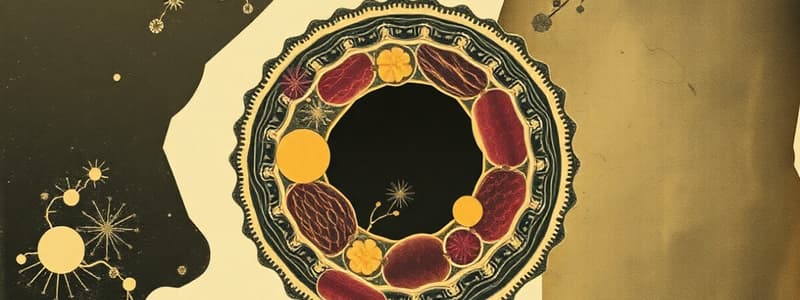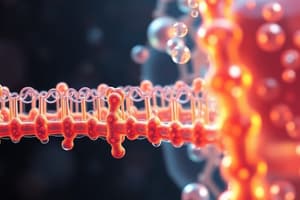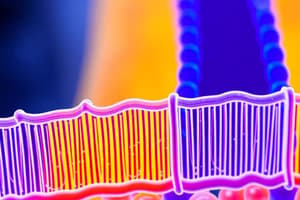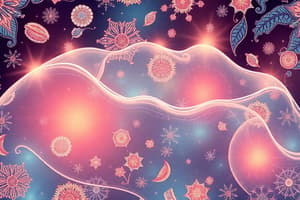Podcast
Questions and Answers
Which component primarily forms the lipid bilayer of the cell membrane?
Which component primarily forms the lipid bilayer of the cell membrane?
- Cholesterol
- Phospholipids (correct)
- Carbohydrates
- Integral proteins
What is the primary function of proteins embedded in the lipid bilayer?
What is the primary function of proteins embedded in the lipid bilayer?
- Acting as receptors for signaling
- Formation of lipid bilayer
- Providing structural support
- Transport across the membrane (correct)
How is the cell membrane viewed under light microscopy?
How is the cell membrane viewed under light microscopy?
- Clear and transparent
- Visible as a thin line
- Appears brownish
- Can’t be seen (correct)
What role do carbohydrates play in the cell membrane?
What role do carbohydrates play in the cell membrane?
What type of structure is the cell membrane described as?
What type of structure is the cell membrane described as?
Which type of membrane protein is loosely bound to the surface of the membrane?
Which type of membrane protein is loosely bound to the surface of the membrane?
What primarily increases the rigidity of the cell membrane?
What primarily increases the rigidity of the cell membrane?
What primarily distinguishes the unit membrane appearance of all organelle membranes?
What primarily distinguishes the unit membrane appearance of all organelle membranes?
What characterizes glandular epithelium?
What characterizes glandular epithelium?
Which type of glandular epithelium loses its connection to the surface?
Which type of glandular epithelium loses its connection to the surface?
What type of epithelium consists of a single layer of flat cells?
What type of epithelium consists of a single layer of flat cells?
Which type of simple epithelium has a single layer of cubical cells?
Which type of simple epithelium has a single layer of cubical cells?
Where can simple columnar epithelium with microvilli be primarily found?
Where can simple columnar epithelium with microvilli be primarily found?
What is the adaptation of simple squamous epithelium that aids in its function?
What is the adaptation of simple squamous epithelium that aids in its function?
Which statement about neuroepithelium is true?
Which statement about neuroepithelium is true?
What is an example of a site for simple squamous epithelium?
What is an example of a site for simple squamous epithelium?
What is the primary function of occludens (tight) junctions?
What is the primary function of occludens (tight) junctions?
Which type of junction is primarily responsible for strong adhesions between adjacent cells?
Which type of junction is primarily responsible for strong adhesions between adjacent cells?
Where are gap junctions commonly found?
Where are gap junctions commonly found?
Which statement best describes connective tissue?
Which statement best describes connective tissue?
What characterizes the structure of connective tissue?
What characterizes the structure of connective tissue?
What is one of the components found within connective tissue?
What is one of the components found within connective tissue?
In which type of connective tissue would you expect to find reticular fibers?
In which type of connective tissue would you expect to find reticular fibers?
Which feature is not typical of connective tissue?
Which feature is not typical of connective tissue?
Which of the following statements accurately describes pseudostratified columnar epithelium?
Which of the following statements accurately describes pseudostratified columnar epithelium?
Where is non-keratinized stratified squamous epithelium typically found?
Where is non-keratinized stratified squamous epithelium typically found?
What is the main function of stratified squamous keratinized epithelium?
What is the main function of stratified squamous keratinized epithelium?
Which type of epithelium has a cuboidal shape in its uppermost layer?
Which type of epithelium has a cuboidal shape in its uppermost layer?
Which statement correctly describes transitional epithelium?
Which statement correctly describes transitional epithelium?
In which locations is ciliated pseudostratified columnar epithelium primarily found?
In which locations is ciliated pseudostratified columnar epithelium primarily found?
What characterizes the superficial layer of stratified squamous non-keratinized epithelium?
What characterizes the superficial layer of stratified squamous non-keratinized epithelium?
What is a key feature of stratified columnar epithelium?
What is a key feature of stratified columnar epithelium?
What is the primary function of plasma cells?
What is the primary function of plasma cells?
Which type of adipose cell is primarily responsible for temperature regulation in newborns?
Which type of adipose cell is primarily responsible for temperature regulation in newborns?
In what connective tissue is dense irregular collagenous connective tissue primarily found?
In what connective tissue is dense irregular collagenous connective tissue primarily found?
Which connective tissue type is characterized by regular collagen bundles that resist tensile forces?
Which connective tissue type is characterized by regular collagen bundles that resist tensile forces?
What is a significant feature of multilocular adipose tissue?
What is a significant feature of multilocular adipose tissue?
Where are brown adipose cells primarily located in adults?
Where are brown adipose cells primarily located in adults?
Which feature is characteristic of elastic connective tissue?
Which feature is characteristic of elastic connective tissue?
What type of immune cell is known for leaving the bloodstream to perform immune functions?
What type of immune cell is known for leaving the bloodstream to perform immune functions?
Flashcards
Cell Membrane Structure
Cell Membrane Structure
The cell membrane is a thin, trilaminar structure composed of a lipid bilayer (50% lipids, 50% protein) with embedded proteins and carbohydrates on the outer surface.
Lipid Bilayer
Lipid Bilayer
The fundamental structure of the cell membrane, formed by phospholipids with hydrophilic heads and hydrophobic tails.
Integral Proteins
Integral Proteins
Proteins embedded within the lipid bilayer, often acting as transport channels, carriers, or pumps.
Peripheral Proteins
Peripheral Proteins
Signup and view all the flashcards
Glycocalyx
Glycocalyx
Signup and view all the flashcards
Simple Squamous Epithelium
Simple Squamous Epithelium
Signup and view all the flashcards
Simple Cuboidal Epithelium
Simple Cuboidal Epithelium
Signup and view all the flashcards
Simple Columnar Epithelium
Simple Columnar Epithelium
Signup and view all the flashcards
Stratified Squamous Epithelium
Stratified Squamous Epithelium
Signup and view all the flashcards
Tight Junctions
Tight Junctions
Signup and view all the flashcards
Connective Tissue
Connective Tissue
Signup and view all the flashcards
Fibroblasts
Fibroblasts
Signup and view all the flashcards
Study Notes
Cell Membrane (Plasma Lemma)
- The thinnest layer surrounding the cell, measuring 8-10nm
- Not visible under light microscopy
- Composed of three layers (trilaminar): outer electron dense layer, inner electron dense layer, and an intermediate electron lucent layer
- This trilaminar structure is found in all organelle membranes, hence the term 'unit membrane'
- A fuzzy (filamentous) electron dense layer on the outer aspect is called the cell coat
- Its molecular structure consists of 50% lipid and 50% protein, along with carbohydrates on the outer surface
Lipids
- Occupy 50% of the cell membrane and have a hydrophilic head and hydrophobic tail
- Phospholipids form a lipid bilayer, with cholesterol located in the inner and outer half of the bilayer
- The cholesterol stabilizes the membrane and increases its rigidity
Proteins
- Occupy 50% of the cell membrane and are divided into two types:
- Integral or intrinsic: embedded in the lipid bilayer and function as transport proteins (carriers, pumps, channels)
- Peripheral or extrinsic: loosely bound to the membrane and are part of the cytoskeleton
Carbohydrates
- Located on the outer aspect of the cell membrane and form glycoproteins and glycolipids
- Together they form the glycocalyx, observed as a fuzzy (filamentous) layer under electron microscopy
- Function as specific receptors for adhesion, recognition, and response to hormones
- Epithelial cells are continuously renewed and replaced
Epithelial Tissue
- Classified into three types: surface epithelium, glandular epithelium, and neuroepithelium
- Surface epithelium covers surfaces or lines cavities
- Glandular epithelium is a special type of epithelium with a secretory function
- Neuroepithelium is a specialized epithelium modified to receive sensory stimuli and convert them into electrical impulses
Surface Epithelium
- Classified based on the number of cell layers into simple epithelium (single layer) and stratified epithelium (multiple layers)
Simple Epithelium
- Simple squamous epithelium: one layer of flat cells with a flat nucleus, found lining blood vessels (endothelium), serous membranes (mesothelium), lung alveoli, and Bowman's capsule of the kidney
- Simple cuboidal epithelium: one layer of cube-shaped cells with a rounded central nucleus, found lining ducts of glands
- Simple columnar epithelium: one layer of columnar cells with a basal oval nucleus, can be unmodified or modified (secretory, absorptive, or ciliated)
- Unmodified: lines ducts of glands
- Secretory: lines the stomach
- Absorptive: contains microvilli for increased surface area, lines the small intestine
- Ciliated: contains cilia, lines the uterus
- Pseudostratified columnar epithelium: cells appear crowded but all rest on the basement membrane, some cells appear short and don't reach the surface, nuclei appear at different levels, found in the large ducts of salivary glands (non-ciliated) and in the trachea and bronchi (ciliated)
Stratified Epithelium
- Stratified squamous epithelium: multiple layers of cells, can be non-keratinized or keratinized
- Stratified squamous non-keratinized: basal layer of columnar cells, intermediate layer of polygonal cells, superficial layer of thin squamous cells, found in wet surfaces like the oral cavity, tongue, esophagus, cornea, anal canal, and vagina
- Stratified squamous keratinized: similar to non-keratinized but upper layer is covered by a non-living layer of keratin, tough, resistant to friction, impermeable to water, found in the epidermis of the skin
- Stratified cuboidal epithelium: uppermost layer of cells are cubical in shape
- Stratified columnar epithelium: uppermost layer of cells are columnar in shape
- Transitional epithelium (Urothelium): highly specialized to withstand distension, found in the urinary system, composed of 6-8 layers in the empty state and 2-3 layers in the stretched state
Cell Junctions
- Provide intercellular connection and communication
- Occludens (tight) Junction: fusion of outer layers of two adjacent cell membranes to prevent substance passage between cells, found in the intestinal epithelium and endothelium of blood capillaries
- Adhering Junction (desmosomes and zonula adherens): lateral borders of adjacent cells connected by filaments to form strong adhesion, found in intestinal epithelium and epidermis of the skin
- Gap Junctions (Communicating Junction): cells have a narrow intercellular space joined by channels allowing communication and passage of substances, found in non-epithelial tissues like cardiac muscle fibers, nerve cells, bone cells, and smooth muscle fibers
Connective Tissue
- Connects, binds, and supports other tissues and organs
- Few cells and wide intercellular space filled with extracellular matrix (ECM)
- Penetrated by blood vessels, lymphatics, and nerves
Connective Tissue Cells
- Fibroblasts: most common cell type, responsible for synthesizing ECM fibers and ground substance
- Chondroblasts and chondrocytes: specialized cells found in cartilage, responsible for synthesizing cartilage matrix
- Osteoblasts and osteocytes: specialized cells found in bone, responsible for synthesizing bone matrix
- Plasma Cells: derived from B-lymphocytes, synthesize and secrete antibodies
- Fat Cells (adipocytes): store fat, can be unilocular (white adipose tissue) or multilocular (brown adipose tissue)
- Unilocular: found in subcutaneous tissue, around blood vessels, and kidneys, function in fat storage, insulation, and support
- Multilocular: found in fetuses and newborns, generate heat, reduce with age, found in the interscapular and neck region
- Free cells: found in connective tissue, include leucocytes, plasma cells, mast cells, and free macrophages
Special Types of Connective Tissue Proper
- Dense Collagenous Connective Tissue: primarily composed of collagen fibers and fibroblasts, can be irregular or regular
- Dense irregular collagenous connective tissue: fibroblasts and irregular bundles of collagen fibers, resist stretch from all directions, found in organ capsules, periosteum, and perichondrium
- Dense regular collagenous connective tissue: fibroblasts and regular collagen bundles, resist tensile forces in one direction, found in tendons and ligaments
- Elastic Connective Tissue: fibroblasts and elastic fibers, found in ligamentum nuchae
- Reticular Connective Tissue: fibroblasts and reticular fibers forming networks, found in the stroma of organs
Studying That Suits You
Use AI to generate personalized quizzes and flashcards to suit your learning preferences.




